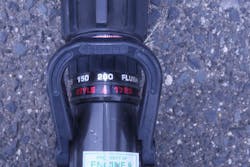Firefighters preparing to engage in a basic foam operation must have a working knowledge of the basics. There is some vocabulary that if used incorrectly, can lead to confusion.
Foam concentrate typically comes in 5-gallon pails, or for more major types of operations can be found in 55-gallon drums and even larger storage capacities such as storage containers, called totes, that hold up to 250 gallons of concentrate or more. Foam concentrate must be added into the water stream in the proper ratio.
All of our members, regardless of the facility or community they protect should be thoroughly familiar with the concentrates in use by their department. Consult the web sites for each of the major manufacturers for specific details. See the references at the end of the first part of this series for many high-quality information sources.
For the more typical foam concentrates used on Class B fires, we find manufacturers making concentrates designed to be mixed with water at a 1%, 3%, or 6% ratio. In other words, depending on the type of foam, or the type of fuel, foam concentrate is designed to be mixed with 99 parts water to 1 part concentrate (1 % foam concentrate), 97 parts water to 3 parts (3% foam concentrate), or 94 parts water to 6 parts concentrate (6% foam concentrate).
Foam Solution is the mixing in the correct ratio of water to foam concentrate. After the water and the foam concentrate have been mixed together, the liquid in the hoseline is no longer water alone, nor is it foam concentrate. Rather, we have what is called a foam solution that is only missing one final ingredient.
Finished Foam is the mixing of air (aspiration) to the foam solution in the hoseline. The air being injected into the discharge stream creates the bubbles and “suds” that give foam its finished appearance. This “aeration” gives foam a power to remain in place for a period of time. For example, a thick blanket of foam that may be several inches thick will continue to provide protection and prevent the release of flammable vapors.
Finished foam has great properties in its ability to prevent the release of flammable vapors from mixing with air due to foam’s ability to float on top of a spill and present a barrier between the air and the fuel source. Nevertheless, this foam blanket will not last forever and eventually begins to degrade, especially if affected by fire or residual heat. A foam blanket’s “drain time” is discussed below.
A critical point to be aware of is finished foam’s compatibility with other types of extinguishing agents. As an example, finished foams such as Aqueous Film Forming Foam (AFFF) and Film Forming Fluoroprotein (FFFP) are compatible with dry chemical, and a coordinated attack can be achieved. Always check with the manufacturer regarding the foam concentrate your department uses to see if it is compatible with agents such as dry chemical.
Finished foam can be compatible with various types of extinguishing agents but, ironically, a plain water stream used near a foam stream will only wash away and dilute the finished foam. Therefore, coordination of hoselines is a requirement prior to any application. Even after the finished foam blanket has been applied and is doing its job to prevent the release of vapors, any application of water can destroy this blanket, so use caution near it!
Drain time is how long it takes for a foam blanket to break down. Finished foam can potentially deliver a thick, rich blanket to cover a spill or fire. As time passes, the finished foam blanket begins to degrade. The drainage rate is based on how long 25% of the foam blanket takes to break down. Eventually, a reapplication will be required or the danger of flammable vapors will resurface. If the fuel is hot or the surroundings that contain the fuel are hot, the foam blanket will degrade even more quickly.
The application of foam requires the mixing of the three key ingredients – concentrate, water, and air – in the proper ratio. This finished foam is applied so that it blankets the fuel and excludes the vapors from mixing with the air. This smothering effect prevents the ignition of a spill, or should a fire occur, the finished foam spreads across the fuel and creates a film or barrier.
Water by itself can create additional problems if used on a spill. Fuels that are lighter in weight than water will rise to the top and continue to burn. Even worse, such an application could create a “running” fuel fire where the spill begins to meander downhill creating a river of flame. Polar solvents on the other hand, will mix readily with water.
Finished foam changes the properties of water to an extinguishing agent that is lighter than the flammable or combustible liquids. This change in physical properties gives us the advantage to attack a fire by creating that blanket or barrier on top of the fuel.
In the event a polar solvent fuel was to be attacked, the department would rely on an alcohol-resistant concentrate. This concentrate creates a protective “polymer-based” membrane that also prevents the mixing of fuel vapors with air. To our good fortune, the fire service has access to dual-purpose foams that can be used on both polar solvents and hydrocarbons, such as Alcohol-Resistant AFFF (AR-AFFF). Check with the manufacturer as to the proper ratio to which such foam concentrates should be applied.
For example, past AR-AFFF foams read 3% x 6% foam concentrates. This meant that for a hydrocarbon spill, the ratio of concentrate to water had to be 3%, while a spill involving polar solvents had to be 6%. Newer foams may have different percentages such as 3% x 3% (3% ratio with water for either hydrocarbon or polar solvents), while some foam concentrates rely on a 1% ratio.
In short, know your equipment before it has to be used. Read the directions on the 5-gallon pail of foam that’s on your engine, before it’s needed. The information that’s listed on these containers is of great value. It tells you the uses for and limitations of the concentrate.
We’ll talk later about the proper application of the finished foam blanket, but for our purposes now, let it be understood that foam should be applied in a manner that does not disturb the fuel, such as by banking the foam stream off an object and letting it cascade down on top of the fuel and spread out over top. We want to avoid plunging the stream into the spill as this creates a more dangerous situation.
One of the other advantages of some of today’s foams such as FFFP or AFFF is the ability to shed fuel. This is advantageous because the finished foam will rise to the top and spread out creating that barrier we talked of earlier.
The additional benefits of foam are the ability to create a cooling environment. Foam is mainly water (94% to 99%) and as such it has the advantages of water’s cooling properties. A spill that has ignited and is within a metal barrier such as a tank for example, can reap the benefits of foam’s cooling ability. Lowering the temperature of everything associated with the spill or fire pays large dividends for obvious reasons.
One other important note; as we said, foam is mainly water and therefore can create an electrocution hazard. A foam stream should not be used on energized electrical equipment. For fires involving Class C equipment, it is always a safe practice to de-energize the source before applying the stream.
Also, fuels that are too hot can react negatively to the application of foam and break the foam blanket down rapidly. For the typical spills and Class B fires that we respond to, this is not much of an issue, but does require knowledge, just to be safe.
In the next article in this series, we’ll discuss the proportioning of foam concentrate and introduce the typical in-line eductor. The next article in the series is going to build upon all we have covered up to this point. In the meantime, take a look at the foam concentrates you have on your apparatus or in fire station storage. Ask yourself these questions, or as part of a company drill, find out the answers to these:
- What kind of concentrate does the department use (AFFF, AR-AFFF, FFFP)?
- What do the instructions say? Does it mention a shelf life? Does it say if it can be used with saltwater?
- Is your foam compatible with dry chemical extinguishing agents?
- What ratio is the concentrate to be mixed with water (1%, 3%, 6%)?
- Is it for Class B fires??? Very important to know!!!
- What are the limitations identified on the label?
- Based on the label, what are the advantages that the foam concentrate offers?
ARMAND F. GUZZI JR. has been a member of the fire service since 1987. He is a career fire lieutenant with the City of Long Branch, NJ, Fire Department and is the deputy director of the Monmouth County, NJ, Fire Academy where he has taught for over 20 years. He has a masters degree in management and undergraduate degrees in fire science, education, and business administration. View all of Armand's articles here. He can be reached via e-mail at [email protected] or [email protected].
About the Author

Armand Guzzi
Firehouse.com Contributor
Armand F. Guzzi, Jr. has been a member of the fire service since 1987. He recently retired a career fire lieutenant with the City of Long Branch, NJ, Fire Department and is the deputy director of the Monmouth County, NJ, Fire Academy where he has taught for over 20 years. He has a Master's degree in management and undergraduate degrees in fire science, education, and business administration. View all of Armand's articles here. He can be reached via e-mail at [email protected] or [email protected].
